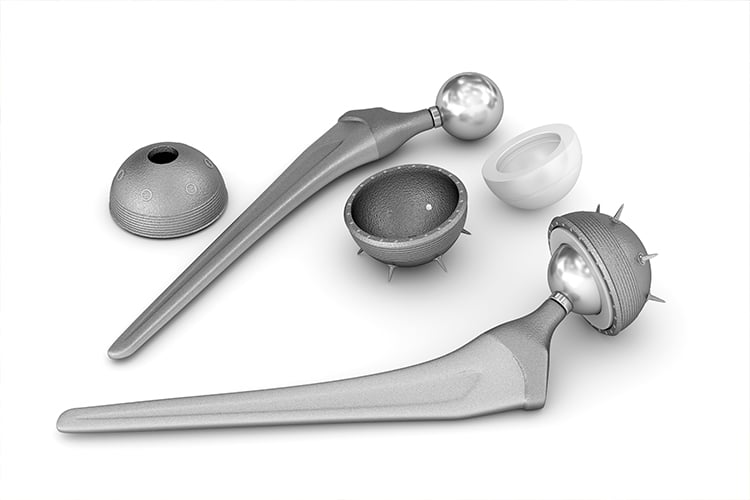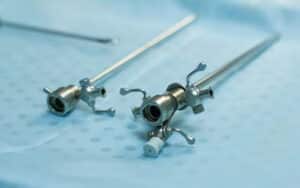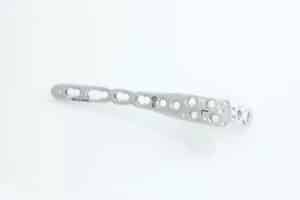
Biochrome coatings are of paramount importance for surgical tools, instruments, and medical applications. Not only do biochrome coatings provide protection, longevity, and aesthetic appeal, but they are also very versatile. They can be included proactively, in the product design phase, or reactively, in cases where an existing design might need additional durability to be used in a new application.
Another product consideration is the type of biochrome coating finish used to design and maintain medical-grade stainless steel and aluminum devices. While they do have some benefits in common, satin, non-reflective, and platinum finishes also contain unique properties that make each ideal for different biochrome coating applications.
Satin Finishes
Highly versatile, satin finishes are an excellent option for a variety of medical applications, including surgical instruments, dental instruments, and orthopedic implants. A variety of methods achieve the soft, semi-gloss appearance and low level of light reflection characteristic of satin finishes.
Abrasive Blasting
Abrasive metal blasting, also known as sandblasting or grit blasting, involves using a high-pressure stream of abrasive particles. You can create a satin finish on a metal surface through metal blasting by controlling the abrasive material’s size and type, the blasting stream’s pressure and velocity, and the nozzle’s distance from the surface.
To create a satin finish, a smaller abrasive material, such as glass beads or aluminum oxide, is typically used. The smaller particles produce a gentler impact on the metal surface, resulting in a smoother finish. Additionally, the blasting pressure and velocity are typically reduced to prevent over-abrasion of the surface.
The distance between the blasting nozzle and the metal surface is also a critical factor in achieving a satin finish. By increasing the distance, the impact of the abrasive particles is reduced, resulting in a more subtle surface texture. Adjusting the angle and pattern of the blasting stream can also achieve the desired satin finish.
Electrochemical Etching
Unlike abrasive blasting, this process uses electrical current to remove a thin layer of metal from the surface, resulting in a smooth finish.
In the electrochemical etching process, the metal surface connects to the positive terminal of a direct current (DC) power source, and the negative terminal connects to a cathode. The process involves immersing the metal surface in an etching solution containing an electrolyte and an etching agent, followed by the application of DC power. The electrical current passing through the solution causes the metal to dissolve, creating a uniform satin finish.
The main advantage of electrochemical etching is that it is highly controllable — perfect for the often irregularly shaped surfaces of complex surgical instruments and medical device surfaces.
Mechanical Brushing
Also known as abrasive brushing or satin brushing, this process applies fine-diameter wire brushes or pads to the metal surface with consistent pressure and speed. The direction of the brushing pattern can also be adjusted to achieve a desired aesthetic.
Various tools, including hand-held devices or automated machinery, can perform mechanical brushing, a relatively simple process.
Benefits of Satin Finishes
When applied to medical-grade equipment, biochrome coating satin finishes offer:
- Reduced glare. High-gloss finishes reflect light and create glare — an unwanted distraction in the operating room. This can be distracting and make it difficult to see the equipment properly. Satin finishes reduce glare and make it easier to perform procedures in various lighting conditions.
- Improved durability. Satin finishes are less prone to scratches and other surface damage than high-gloss finishes, making them more durable and resistant to galling, fretting, and corrosion from sterilization and laser marking.
- Enhanced hygiene. Satin finishes are easier to clean than high-gloss finishes. A non-stick satin finish biochrome coating reduces bacteria buildup and is easier to sterilize and keep clean.
- Improved aesthetics. Surgical and dental equipment coated with a satin finish will look like new after hundreds of uses, providing a high level of confidence among medical providers and patients.
- Reduced cost. Satin finishes can be less expensive to produce than high-gloss finishes, making them a cost-effective option to build into product design processes.

Image of tubes for laparoscopic examination are prepared for surgery.
Non-reflective Finishes
Ideal for laparoscopes, endoscopes, and other devices used for minimally invasive medical procedures, non-reflective finishes are similar to satin finishes in that they minimize glare and reflections that can interfere with visibility during surgery.
However, there are some differences in terms of how this is achieved. The soft, brushed texture of the satin finish scatters light, resulting in a low-to-medium reflectivity that is typically less reflective than a polished or mirror finish. Non-reflective finishes, however, create a completely matte surface on the metal. This surface does not reflect light, resulting in a reflectivity that is close to zero.
Benefits of Non-reflective Finishes
Chemical processes, such as chemical etching or applying a non-reflective material coating, typically create non-reflective finishes. Advantages of non-reflective finishes include:
- Near-zero glare. Non-reflective greatly reduces the amount of light reflected off the surface of medical equipment, making it an excellent choice for surgical procedures.
- Improved accuracy. Non-reflective finishes can help prevent glare and reflections from interfering with the accuracy of medical instruments or equipment, particularly those used for surgical procedures or other precision work.
- Increased safety. By reducing glare and reflections, non-reflective finishes can increase the safety of medical professionals and patients by preventing distractions or accidental exposure to bright light.
- Improved aesthetics. Non-reflective finishes can also enhance the appearance of medical equipment by providing a matte or satin finish that is both attractive and functional.

Image of a platinum medical fracture bone surgical orthopedic implant
Platinum finishes
From maintaining cutting edges on drills and reamers to sealing and protecting medical instruments, platinum finishes are well-known for biocompatibility and corrosion resistance.
Physical vapor deposition (PVD) is one of the most effective methods for creating a platinum finish on metal. In this surface coating process, operators place the metal into a vacuum chamber and use an electron beam or an arc to evaporate platinum onto it. They often deposit a thin layer of adhesion material onto the metal before adding the platinum layer. The evaporated platinum condenses onto the surface of the metal, forming a thin, durable, high-quality finish.
Benefits of Platinum Finishes
- Increased corrosion resistance. The resistance of platinum to corrosion and oxidation, along with its suitability for medical equipment exposed to harsh environments, chemicals, or bodily fluids, showcases its excellence.
- Improved durability. The durability of platinum allows it to resist wear and tear over time, making it perfectly suited for medical equipment that undergoes frequent use.
- Biocompatibility. Platinum, being a biocompatible material, tolerates well within the human body without causing adverse reactions or immune responses. This makes it a safe and effective choice for medical implants or other devices that may come into contact with bodily tissues or fluids.
- Enhanced conductivity. Platinum is an excellent conductor of electricity and heat, making it ideal for medical devices that require precise electrical or thermal properties, such as electrodes or heating elements.
- Improved aesthetics. Platinum has a distinctive silver-white color and a lustrous, polished finish that can enhance the appearance of medical equipment and give it a premium, high-end look.
Versatile Biocompatible Coatings and Finishes from ME-92®
For decades, the medical industry has utilized ME-92® and AL-COAT® coatings to reduce friction and wear, take advantage of nonstick coating properties, and of course, be non-reactive to the body.
Let our metallurgical and materials consulting, research, and testing experts help you determine the right coating and finish to extend the life of your medical devices.